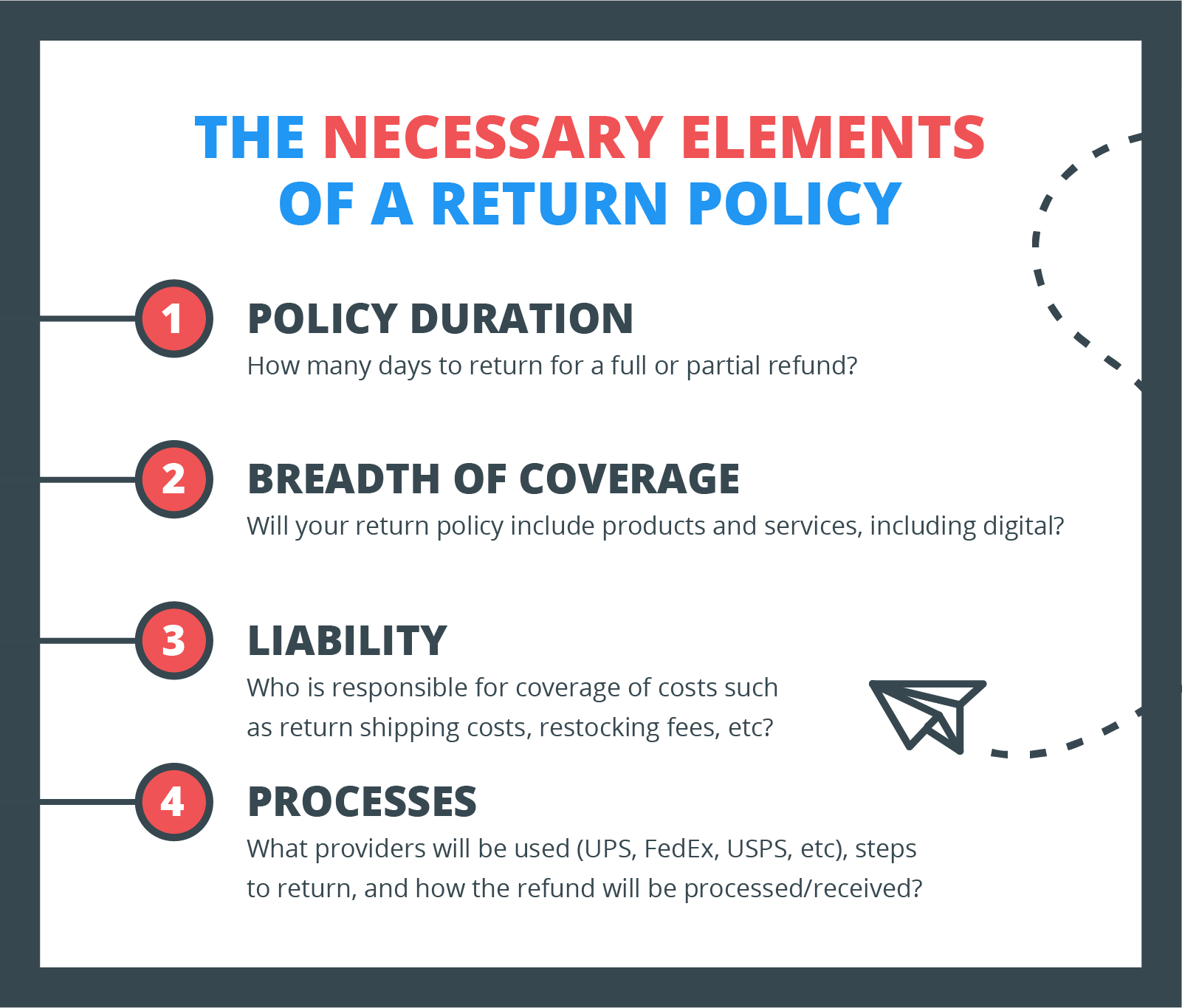
Full Answer
What is a return policy?
Return policies are the rules a retailer creates to manage how customers return and exchange unwanted merchandise they purchased. A return policy tells customers what items can be returned and for what reasons, and the timeframe over which returns are accepted.
What should be included in a return and refund policy?
A return and refund policy is an agreement between customers and your business regarding returns and refunds. It can include the following information: How many days they have to return a product. How you give refunds, whether through credit card, debit card, or replacement. Who pays the shipping charges for returns.
How do I start a return policy on my website?
You can also start a return with one click. If the return policy is clearly outlined on your website so it can’t be missed by customers, the right expectations will be set before the purchase is made. There will likely be some customers who are unsatisfied with your store's policy, but hiding the policy in fine print only leads to a lack of trust.
What is a return merchandise system?
A return merchandise system helps you handle returns for your customers. It lets customers initiate a return, receive a pre-paid label with an RMA number, and ship the return without taking up your time.

Does feature have free returns?
If you are unsatisfied with your order, all eligible items can be returned for store credit within 16 days of the original purchase date. Once a return is started, please note that all tags must be attached, the packaging must be intact, and the product must be unused/unworn.
What are the returns policy?
Return policies are the rules a retailer creates to manage how customers return and exchange unwanted merchandise they purchased. A return policy tells customers what items can be returned and for what reasons, as well as the timeframe over which returns are accepted.
What should my return policy be?
It's important to let your customers know how long they have to return a product. Generally speaking, 15-30 days is standard, although some businesses opt for 90 days. Either way, you won't be doing yourself any favors by accepting returns beyond that time.
What is 30 day return policy?
For example, the 30 days could mean that you have to exchange the purchase within 30 days of purchasing the items. It could also mean that you have 30 days to use a promotion or discount within the store.
Can a company not accept returns?
While many retailers have decided this makes for the best business practice, they aren't legally required to accept returns. Rather, retailers are required to accept returns only if the sold good is defective or if they otherwise break the sales contract.
Can a business say no refunds?
There are no federal laws that require a merchant to refund money unless the product they sell turns out to be defective, despite the federal consumer protection regulation enforced by the Federal Trade Commission (FTC).
Can you return a product if you don't like it?
What if I don't have the receipt? If you can't get hold of the receipt and you're taking an item back simply because you don't like it, the retailer is under no legal obligation to give you a refund – but the retailer may offer you an exchange or a credit note.
In what circumstances can you insist on a refund?
If a consumer cancels their contract of sale with the seller, they are entitled to insist on a full refund. A seller may not insist the consumer receive another form of remedy (such as repair or replacement goods) or insist that the refund be issued as store credit.
How important is a return policy?
A concise and clear return policy gives consumers a feeling of security; that what they are buying is guaranteed to be what it is represented to be. If a retailer doesn't give this guarantee, then consumers often become suspicious and avoid buying the product.
Can I return an item past 30 days?
Under the Consumer Rights Act, you have the right to return something within 30 days and get all of your money back if it's faulty, not as described, or unfit for purpose.
How long after purchase can I return goods?
between 28-30 daysIf a retailer does have a returns policy, then you'll usually have between 28-30 days to return an item and get a refund or exchange.
How long do I have to return something?
Under the Consumer Rights Act, you have a right to return something and get your money back if it's faulty. You're only entitled to an automatic refund if you return it within 30 days, otherwise the retailer can repair or replace it. The time frame for returning goods for a refund can vary though.
What does the Consumer Protection Act say about refunds?
Does the Consumer Protection Act (CPA) require the retailer to refund unopened goods bought in error with a slip, two days after purchase? No. Legally, retailers aren't compelled to take back non-defective goods at all. The CPA doesn't cover the return of non-defective goods, at all.
In what circumstances can you insist on a refund?
If a consumer cancels their contract of sale with the seller, they are entitled to insist on a full refund. A seller may not insist the consumer receive another form of remedy (such as repair or replacement goods) or insist that the refund be issued as store credit.
Is a return a refund?
No. A return is when a customer sends an item back to your store or warehouse. They usually have to return an item before they get a refund. A refu...
What is a return and refund policy?
A return and refund policy is an agreement between customers and your business regarding returns and refunds. It can include the following informat...
Are refunds legally required?
Depending on your country and state laws, you can technically have a no refund, no return policy. But a no return policy can make customers distrus...
How do I make a return policy?
Create a return policy that builds trust with customers. Be clear and concise when writing your return policy. Don't demand things from your custom...
What is a return policy?
Return policies are the rules a retailer creates to manage how customers return and exchange unwanted merchandise they purchased. A return policy tells customers what items can be returned and for what reasons, and the timeframe over which returns are accepted.
Why do we need a return and exchange policy?
Just like having a formal return and exchange policy will help eliminate some of the hours spent on customer service, using the right services for processing returns and exchanges will save you both time and money on the shipping and fulfillment and operations sides.
What is the difference between returns and exchanges?
When a customer returns a product for a refund, the business usually loses money on the customer acquisition and return shipping costs, plus it needs to refund the customer any profit made on the original order.
How to encourage exchanges over returns?
A common way to encourage exchanges over returns is by only offering to cover the cost of return shipping if the customer chooses to exchange the product. When presented with the three options above, the choice to get a store credit or new product may be more appealing to those who have not fully sworn off your brand.
What does it mean to return something in ecommerce?
In ecommerce, the customer usually decides independently if they want a return (which signifies a refund ) or an exchange (usually for a gift card or a replacement product of equal value).
What is returnly app?
Returnly is one of the larger self-service returns providers for ecommerce stores. The app provides online stores with their own customizable “Returns Center,” which customers can sign into using their order number or email address to access their past purchases and select items they wish to return.
When a customer chooses to return a product for a refund or exchange, one risk a company often
When a customer chooses to return a product for a refund or exchange, one risk a company often takes on is whether or not it will be able to resell the item.
